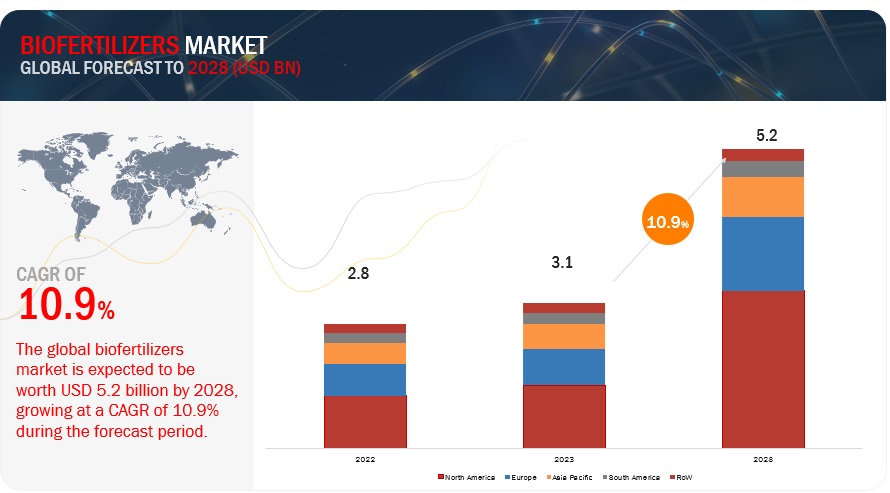The global biofertilizers market was valued at USD 2.8 billion in 2022 and is projected to grow to USD 5.2 billion by 2028, registering a CAGR of 10.9% during the forecast period. The market’s expansion is driven by the increasing availability of farmland worldwide. According to FiBL, organic farmland reached 76 million hectares in 2021. Rising concerns about environmental health and the adverse effects of synthetic fertilizers on crops have further fueled the demand for biofertilizers across various regions. Additionally, government initiatives promoting sustainable agricultural practices are boosting market growth.

The biofertilizers market is evolving rapidly as agriculture becomes more focused on sustainability and eco-friendly practices. Some key trends influencing this market include:
- Shift Toward Organic Farming: With an increasing demand for organic produce, biofertilizers are gaining popularity as an alternative to synthetic fertilizers, promoting soil health and reducing environmental impact.
- Government Initiatives and Support: Many governments are offering subsidies and grants to encourage the adoption of biofertilizers, which is driving growth in the market. Regulatory frameworks supporting environmentally friendly practices are also playing a role.
- Technological Advancements: The development of new biofertilizer products, such as microbial inoculants, and the use of advanced technologies like nano-biofertilizers, is enhancing their effectiveness and efficiency.
- Environmental Concerns: Growing awareness of the negative environmental effects of chemical fertilizers, such as soil degradation and water pollution, is motivating farmers to adopt biofertilizers as a more sustainable alternative.
- Increase in Demand for Sustainable Agriculture: Consumers are becoming more concerned about the environmental impact of food production. This is pushing farmers toward adopting sustainable practices, which include using biofertilizers to maintain soil fertility and reduce chemical runoff.
- Rising Investment in R&D: There is a surge in investment in research and development to improve biofertilizer formulations, optimize their effectiveness for different crops and environments, and expand their application in various agricultural sectors.
- Global Expansion: While biofertilizers have seen strong growth in developed regions like North America and Europe, emerging markets in Asia-Pacific, Latin America, and Africa are showing significant adoption due to increasing agricultural activities and the need for eco-friendly farming solutions.
Download PDF Brochure: https://www.marketsandmarkets.com/pdfdownloadNew.asp?id=856
By Type: Nitrogen-Fixing Biofertilizers to Dominate
Nitrogen-fixing biofertilizers are expected to hold the largest market share during the forecast period. These biofertilizers enhance crop yields through improved biological nitrogen fixation, nutrient uptake, and stimulation of plant growth via hormonal actions or organic waste breakdown. Their use as a partial substitute for chemical fertilizers reduces environmental contamination, lowers costs, and enhances sustainability, driving significant growth in this segment.
By Crop Type: Fruits & Vegetables Leading the Market
The fruits and vegetables segment is forecasted to account for the largest market share during the research period. Biofertilizers are particularly effective in increasing the productivity of crops such as bananas, which require substantial nitrogen. For instance, inoculation with Azotobacter can yield better results than administering full nitrogen doses. Additionally, biofertilizers used in conjunction with VAM fungi enhance nutrient absorption, particularly for mobile nutrients like nitrogen. With the increasing demand for high-quality organic produce, more farmers are adopting microbial biofertilizers to achieve sustainable agricultural practices.
By Mode of Application: Soil Treatment Takes the Lead
The soil treatment segment is anticipated to dominate the biofertilizers market during the study period. Applying liquid biofertilizers directly to the soil is critical in conditions such as hot, dry climates, highly acidic soils, or when seeds are treated with chemicals harmful to rhizobia bacteria. Soil-applied biofertilizers ensure close contact with crop roots, improving nutrient diffusion, yield, and productivity. This mode of application is gaining popularity, further driving segment growth.
North America: Largest Market Share
North America is poised to lead the global biofertilizers market, driven by widespread product availability and competitive pricing. Governments in the region actively encourage eco-friendly agricultural inputs to minimize environmental degradation, further supporting biofertilizer adoption. In countries like the US and Canada, the focus on large-scale cash crop production is also contributing to market growth.
Top Biofertilizers Manufacturers
Prominent players in the biofertilizers market include:
- Novozymes (Denmark)
- UPL (India)
- Chr. Hansen Holding A/S (Denmark)
- Syngenta (Switzerland)
- T. Stanes and Company Limited (India)
- Lallemand Inc. (Canada)
- Rizobacter Argentina S.A. (Argentina)
- Vegalab SA (Switzerland)
- IPL Biologicals Limited (India)
- Kiwa Bio-tech Product Group Corporation (China)
Biofertilizers Industry Development:
- What is the projected market value of the global biofertilizers market?
- What is the estimated market value of the global biofertilizers market in 2023?
- What is the estimated growth rate (CAGR) of the global biofertilizers market for the next five years?
- What are the major revenue pockets in the biofertilizers market currently?
- What kind of information is provided in the competitive landscape section?